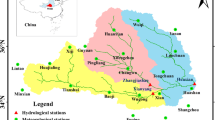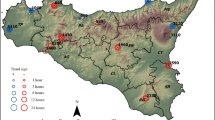Abstract
This paper provides a synoptic view of extreme monsoon floods on all the nine large rivers of South Asia and their association with the excess (above-normal) monsoon rainfall periods. Annual maximum flood series for 18 gauging stations spread over four countries (India, Pakistan, Bangladesh and Nepal) and long-term monsoon rainfall data were analyzed to ascertain whether the extreme floods were clustered in time and whether they coincided with multi-decade excess monsoon rainfall epochs at the basin level. Simple techniques, such as the Cramer’s t-test, regression and Mann–Kendall (MK) tests and Hurst method were used to evaluate the trends and patterns of the flood and rainfall series. MK test reveals absence of any long-term tendency in all the series. However, the Cramer’s t test and Hurst-Mandelbrot rescaled range statistic provide evidence that both rainfall and flood time series are persistent. Using the Cramer’s t-test the excess monsoon epochs for each basin were identified. The excess monsoon periods for different basins were found to be highly asynchronous with respect to duration as well as the beginning and end. Three main conclusions readily emerge from the analyses. Extreme floods (>90th percentile) in South Asia show a tendency to cluster in time. About three-fourth of the extreme floods have occurred during the excess monsoon periods between ~1840 and 2000 AD, implying a noteworthy link between the two. The frequency of large floods was higher during the post-1940 period in general and during three decades (1940s, 1950s and 1980s) in particular.








Similar content being viewed by others
Explore related subjects
Discover the latest articles and news from researchers in related subjects, suggested using machine learning.References
Amarasekar KN, Lee RF, Williams ER, Eltahir EAB (1997) ENSO and the natural variability in the flow of tropical rivers. J Hydrol 300:24–39
Anderson DM, Overpeck JT, Gupta AK (2002) Increase in the Asian SW Monsoon during the past four centuries. Science 297:596–599
Ashok K, Saji NH (2007) On the impacts of ENSO and Indian Ocean dipole events on sub-regional Indian summer monsoon rainfall. Nat Hazard 42:273–285
Bakimchandra O (2006) Reconstruction of 2003 Daya flood. Using multi—resolution and multi—temporal satellite imagery, Enschede
Beard LR (1975) Generalized evaluation of flash-flood potential. Technical report. Center Water Resources, CRWR-124, University of Texas, Austin, pp 1–27
Bhutiyani MR, Kale VS, Pawar NJ (2008) Changing stream flow patterns in the river of northwestern Himalaya: implications of global warming in the 20th century. Curr Sci 95:618–625
Bollasina MA, Ming Y, Ramaswamy V (2011) Anthropogenic aerosols and the weakening of the South Asian summer monsoon. Sci Exp. Published online 29 Sept 2011. doi:10.1126/science.1204994
Bookhagen B, Burbank DW (2010) Toward a complete Himalayan hydrological budget: spatiotemporal distribution of snowmelt and rainfall and their impact on river discharge. J Geophys Res 115:F03019. doi:10.1029/2009JF001426
Chowdhury MR, Ward N (2004) Hydro-Meteorological variability in The Greater Ganges–Brahmaputra–Meghna Basins. Int J Climatol 24:1495–1508
Cook ER, Anchukaitis KJ, Buckley BM, D’Arrigo RD, Jacoby GC, Wright WE (2010) Asian monsoon failure and mega drought during the last millennium. Science 328:486–489
Dhar ON, Nandargi S (2002) Flood study of the Himalayan tributaries of the Ganga River. Meteorol Appl 9:63–68
Dhar ON, Nandargi S (2003) Hydrometeorological aspects of floods in India. Nat Hazard 28:1–33
Ferdows M, Hossain M (2005) Flood frequency analysis at different rivers in Bangladesh: a comparison study on probability distribution functions. Thammasat Int J Sci Tech 10:53–66
Gadgil S (2003) The Indian monsoon and its variability. Annu Rev Earth Planet Sci 31:429–467
Gadgil SP, Vinayachandran PN, Francis P, Gadgil S (2004) Extremes of the Indian summer monsoon rainfall, ENSO and equatorial Indian Ocean oscillation. Geophys Res Lett 31:L12213. doi:10.1029/2004GL019733
Ghosh S, Luniya V, Gupta A (2009) Trend analysis of Indian summer monsoon rainfall at different spatial scales. Atmos Sci Lett 10:285–290
Gole CV (1978) Extrapolation of peak flood by frequency analysis. Proceedings of the 47th R&D session, vol II. CBIP, Hubli-Dharward, pp 1–12
Goswami BN, Venugopal V, Sengupta D, Madhusoodanan MS, Xavier PK (2006) Increasing trend of extreme rainfall events over India in a warming environment. Science 314(5804):1442–1445
Guhathakurta P, Sreejith OP, Menon PA (2011) Impact of climate change on extreme rainfall events and flood risk in India. J Earth Syst Sci 120:359–373
Gupta H, Chakrapani GJ (2007) Temporal and spatial variations in water flow and sediment load in the Narmada River. Curr Sci 92:679–684
Herschy R (2003) World catalogue of maximum observed floods, IAHS-AISH publication number 284, Oxford shire, UK
Hewitt K (1982) Natural dams and outburst floods of the Karakoram Himalaya. In: Glen JW (ed) Hydrological aspects of Alpine and high mountain areas. IAHS publ. no. 138, pp. 259–269
Hurst HE (1951) Long-term storage capacity of reservoirs. J Am Soc Civ Eng 116:770–799
Hurst HE (1957) A suggested statistical model of some time series which occur in nature. Nature 180:494
Inam A, Clift PD, Giosan L, Tabrez AR, Tahir M, Rabbani MM, Danish M (2007) The geographic, geological and oceanographic setting of the Indus River. In: Gupta A (ed) Large rivers: geomorphology and management. Wiley, New York, pp 333–346
Joshi MK, Pandey AC (2011) Trend and spectral analysis of rainfall over India during 1901–2000. J Geophys Res 116:D06104. doi:10.1029/2010JD014966
Kale VS (1999) Long-period fluctuations in monsoon floods in the Deccan Peninsular India. J Geol Soc India 53:5–15
Kale VS (2002) Fluvial geomorphology of Indian rivers–an overview. Prog Phys Geog 26:400–433
Kale VS (2003) Geomorphic effects of monsoon floods on Indian rivers. Nat Hazard 28:65–84
Kale VS, Baker VR (2006) An extraordinary period of low-magnitude floods coinciding with the little ice age: palaeoflood evidence from central and western India. J Geol Soc India 68:477–483
Kantelhardt JW, Koscielny-Bunde E, Rybski D, Braun P, Bunde A, Havlin S (2006) Long-term persistence and multifractality of precipitation and river runoff records. J Geophys Res 111:D01106. doi:10.1029/2005JD005881
Khan M (1967) Influence of Upper Indus basin on the elements of the flood hydrograph at Tarbela-Attock in: flood and their computations. AIHS publication II(85):918–925
Kripalani RH, Kulkarni A (1997) Climatic impact of El Niño/La Nina on the Indian monsoon: a new perspective. Weather 52:39–46
Kripalani RH, Kulkarni A, Sabade S, Khandekar ML (2003) Indian monsoon variability in a global warming scenario. Nat Hazard 29:189–206
Krishnamurthy V, Goswami BN (2000) Indian monsoon–ENSO relationship on inter decadal timescale. J Clim 13:579–595
Kumar JR, Dash SK (2001) Inter decadal variations of characteristics of monsoon disturbances and their epochal relationships with rainfall and other tropical features. Int J Climatol 21:759–771
Kumar KK, Kleeman R, Cane MA, Rajagopalan B (1999a) Epochal changes in Indian monsoon-ENSO precursors. Geophys Res Lett 26:75–78
Kumar KK, Rajagopalan B, Cane MA (1999b) On the weakening relationship between the Indian monsoon and ENSO. Science 284:2156–2159
Kumar V, Jain SK, Singh Y (2010) Analysis of long-term rainfall trends in India. Hydrologic Sci J 55:484–496
Lye LM, Lin Y (1994) Long-term dependence in annual peak flows of Canadian rivers. J Hydrol 160:89–103
Mirza MMQ (1997) Hydrological changes in the Ganges system in Bangladesh in the post—Farakka period. Hydrol Sci J 42:613–631
Mirza MMQ, Warrick RA, Ericksen NJ, Kenny GJ (1998) Trends and persistence in precipitation in the Ganges, Brahmaputra and Meghna river basins. Hydrol Sci J 43:845–858
Mirza MMQ, Warrick RA, Ericksen NJ, Kenny GJ (2001) Are floods getting worse in the Ganges, Brahmaputra and Meghna basins? Environ Hazard 3:37–48
Mohanty S (2007) Population growth and changes in land use in India. Pop Environ Bull 4:1–4
Mooley DA, Parthasarathy B (1984) Fluctuations in all-India summer monsoon rainfall during 1871–1978. Clim Change 6:287–301
Naidu CV, Srinivasa Rao BR, Bhaskar Rao DV (1999) Climatic trends and periodicities of annual rainfall over India. Meteor Appl 6:395–404
Niyas NT, Srivastava AK, Hatwar HR (2009) Variability and trend in the cyclonic storms over north Indian Ocean. Met Monogr, no. 3, Cyclone warning-3/2009
Pal I, Al-Tabbaa A (2010) Regional changes in extreme monsoon rainfall deficit and excess in India. Dynam Atmos Oceans 49:206–214
Panchawagh NV, Vaidya SS (2011) Link between break/active phases of summer monsoon over India and China. Curr Sci 100:1–8
Pant GB, Rupa Kumar K (1997) Climates of South Asia. Wiley Chichester
Pant GB, Rupa Kumar K, Parthasarathy B, Borgaonkar HP (1988) Long-term variability of the Indian summer monsoon and related parameters. Adv Atmos Sci 5:469–481
Parthasarathy B, Rupa Kumar K, Munot AA (1991) Evidence of secular variations in Indian monsoon rainfall-circulation relationship. J Clim 4:927–938
Purohit M U (1972) Role of Ukai project in controlling floods in the lower Tapi region. Ukai Dam Project Souvenir, Surat, pp 25–35
Rajeevan M, Bhate J, Jaswal AK (2008) Analysis of variability and trends of extreme rainfall events over India using 104 years of gridded daily rainfall data. Geophys Res Lett 35:L18707. doi:10.1029/2008GL035143
Ramaswamy C (1987) Meteorological aspects of severe floods in India 1923–1979, MMH no. 10, India Meteorological Department, New Delhi
Ramesh Kumar MR, Krishnan R, Sankar S, Unnikrishnan AS, Pai DS (2009) Increasing trend of “break-monsoon” conditions over India–role of ocean–atmosphere processes in the Indian Ocean. IEEE Geosci Remote Sens Lett 6:332–336
Ranade AA, Singh N, Singh HN, Sontakke NA (2007) Characteristics of hydrological wet season over different river basins of India. Indian Institute of Tropical Meteorology, Pune, Research report no. RR-119
Rangarajan G, Sant DA (2004) Fractal dimensional analysis of Indian climatic dynamics. Chaos Solut Fract 19:285–291
Rao AR, Bhattacharya D (1999) Comparison of Hurst exponent estimates in hydro-meteorological time series. J Hydrol Eng 4:225–231
Rodier JA, Roche MJ (1984) World catalogue of maximum observed floods. IAHS publication number 143
Schulzer EF (1976) Problems in applied hydrology. Water Resource Publication, Fort Collins
Shaukat AA (2003) Pakistan: flood management—River Chenab from Marala to Khanki. The associated programme on flood management. WMO/GWP. http://www.apfm.info/pdf/case_studies/cs_pakistan_chenab.pdf
Sontakke NA, Singh N, Singh HN (2008) Instrumental period rainfall series of the Indian region (1813–2005): revised reconstruction, update and analysis. The Holocene 18:1055–1066
Subbaramayya I, Naidu CV (1992) Spatial variations and trends in the Indian monsoon rainfall. Int J Climatol 12:597–609
Thapliyal V, Kulshrestha SM (1991) Climate changes and trends over India. Mausam 42:333–338
UNESCO (1976) World catalogue of very large floods. Paris
Vashist MK (1981) Technique of flood forecasting. Proceedings of the 49th annual R&D session, CBIP, New Delhi, pp 257–276
WMO (1966) Climatic change, WMO technical note no. 79, WMO no. 195–TP-100. World Meteorological Organization, Geneva
Yue S, Pilon PJ, Phinney B, Cavadias G (2002) The influence of autocorrelation on the ability to detect trend in hydrological series. Hydrol Process 16:1807–1829
Acknowledgments
The author wishes to thank Victor Baker and one anonymous reviewer for reviews and helpful comments.
Author information
Authors and Affiliations
Corresponding author
Additional information
This paper is a contribution to the special issue on Global Monsoon Climate, a product of the Global Monsoon Working Group of the Past Global Changes (PAGES) project, coordinated by Pinxian Wang, Bin Wang, and Thorsten Kiefer.
Rights and permissions
About this article
Cite this article
Kale, V. On the link between extreme floods and excess monsoon epochs in South Asia. Clim Dyn 39, 1107–1122 (2012). https://doi.org/10.1007/s00382-011-1251-6
Received:
Accepted:
Published:
Issue Date:
DOI: https://doi.org/10.1007/s00382-011-1251-6




